

Compact Muon Solenoid
LHC, CERN
| CMS-TOP-20-007 ; CERN-EP-2021-201 | ||
| Search for flavor-changing neutral current interactions of the top quark and Higgs boson in final states with two photons in proton-proton collisions at $\sqrt{s} = $ 13 TeV | ||
| CMS Collaboration | ||
| 3 November 2021 | ||
| Phys. Rev. Lett. 129 (2022) 032001 | ||
| Abstract: Proton-proton interactions resulting in final states with two photons are studied in a search for the signature of flavor-changing neutral current interactions of top quarks (t) and Higgs bosons (H). The analysis is based on data collected at a center-of-mass energy of 13 TeV with the CMS detector at the LHC, corresponding to an integrated luminosity of 137 fb$^{-1}$. No significant excess above the background prediction is observed. Upper limits on the branching fractions ($\mathcal B$) of the top quark decaying to a Higgs boson and an up (u) or charm quark (c) are derived through a binned fit to the diphoton invariant mass spectrum. The observed (expected) 95% confidence level upper limits are found to be 0.019 (0.031)% for $\mathcal B(\mathrm{t} \to \mathrm{H}\mathrm{u})$ and 0.073 (0.051)% for $\mathcal B(\mathrm{t} \to \mathrm{H}\mathrm{c})$. These are the strictest upper limits yet determined. | ||
| Links: e-print arXiv:2111.02219 [hep-ex] (PDF) ; CDS record ; inSPIRE record ; HepData record ; CADI line (restricted) ; | ||
| Figures | |

png pdf |
Figure 1:
Representative Feynman diagrams for the production modes considered: FCNC associated production of a single top quark with a Higgs boson (ST, left), and ${\mathrm{t} {}\mathrm{\bar{t}}}$ production with the FCNC decay of the top quark to a Higgs boson and an up or charm quark (TT, right). The Higgs boson decay to two photons is considered. The FCNC vertex in each process is denoted with a red circle. |
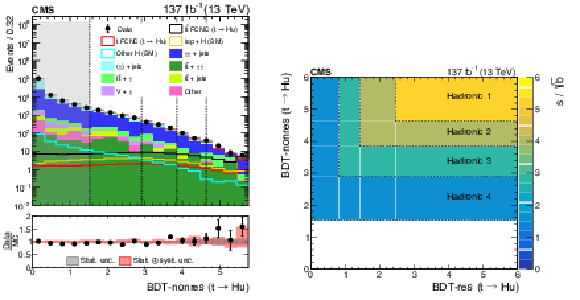
png pdf |
Figure 2:
Left: distribution of the BDT-nonres scores used for the hadronic event categorization targeting ${\mathrm{t} \to \mathrm{H} \mathrm{u}}$ FCNC interactions from data (points) and predictions from simulation (colored histograms). The "Other'' category includes contributions from ${\mathrm{t} {}\mathrm{\bar{t}}}$Z, ${\mathrm{t} {}\mathrm{\bar{t}}}$W, WW, WZ, ZZ, and t+$ \gamma $+jets. The "top + H'' category includes ${\mathrm{t} {}\mathrm{\bar{t}}}$H, tHq, and tHW, while the "Other H'' category includes ggH, VBF, WH, and ZH. The nonresonant background histograms are stacked, while the two signal, "Other H'', and "top + H'' distributions are shown separately. Boundaries defining event categories are indicated with dotted lines in the upper panel. Events in the grey shaded region are not considered in the analysis. The lower panel shows the ratio of the data to the sum of the nonresonant background predictions. The simulated signal and background distributions are normalized to the integrated luminosity of the data, assuming a coupling of unity for the signal. Statistical and total (statistical $\oplus $ systematic) background uncertainties are represented by the grey- and red-shaded bands, respectively. The (\gamma) + jets sample of multijet and {\gamma + \text {jets}} events from data is not assigned a systematic uncertainty, as described in the text. Right: hadronic event categorization targeting ${\mathrm{t} \to \mathrm{H} \mathrm{u}}$ FCNC interactions from requirements placed on BDT-nonres (horizontal dotted lines) and BDT-res (vertical dotted lines). The color denotes the $s/\sqrt {b}$ of each category. |
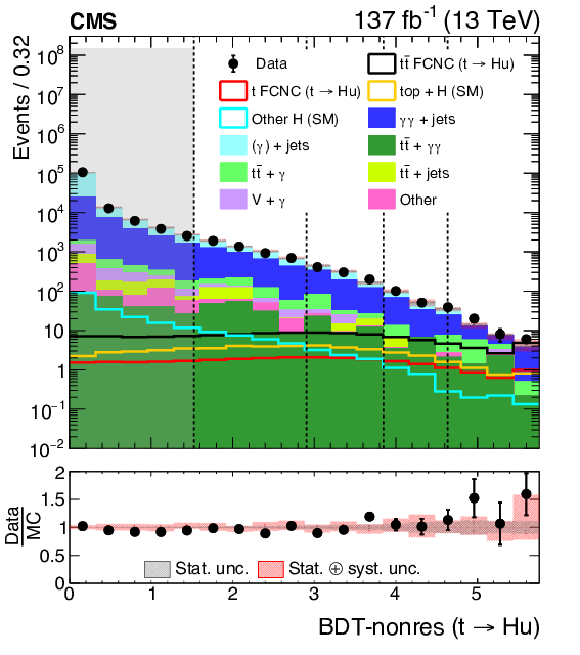
png pdf |
Figure 2-a:
Distribution of the BDT-nonres scores used for the hadronic event categorization targeting ${\mathrm{t} \to \mathrm{H} \mathrm{u}}$ FCNC interactions from data (points) and predictions from simulation (colored histograms). The "Other'' category includes contributions from ${\mathrm{t} {}\mathrm{\bar{t}}}$Z, ${\mathrm{t} {}\mathrm{\bar{t}}}$W, WW, WZ, ZZ, and t+$ \gamma $+jets. The "top + H'' category includes ${\mathrm{t} {}\mathrm{\bar{t}}}$H, tHq, and tHW, while the "Other H'' category includes ggH, VBF, WH, and ZH. The nonresonant background histograms are stacked, while the two signal, "Other H'', and "top + H'' distributions are shown separately. Boundaries defining event categories are indicated with dotted lines in the upper panel. Events in the grey shaded region are not considered in the analysis. The lower panel shows the ratio of the data to the sum of the nonresonant background predictions. The simulated signal and background distributions are normalized to the integrated luminosity of the data, assuming a coupling of unity for the signal. Statistical and total (statistical $\oplus $ systematic) background uncertainties are represented by the grey- and red-shaded bands, respectively. The (\gamma) + jets sample of multijet and {\gamma + \text {jets}} events from data is not assigned a systematic uncertainty, as described in the text. |
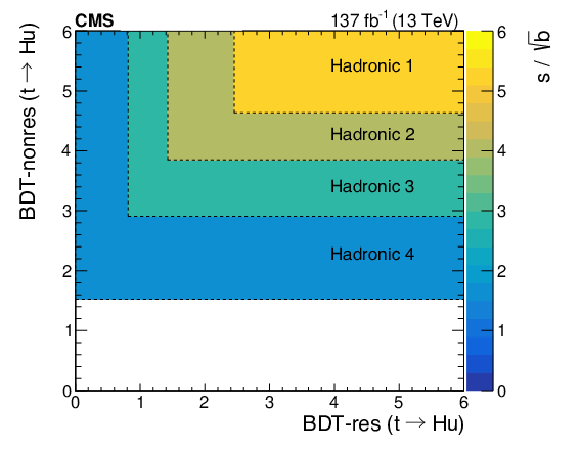
png pdf |
Figure 2-b:
Hadronic event categorization targeting ${\mathrm{t} \to \mathrm{H} \mathrm{u}}$ FCNC interactions from requirements placed on BDT-nonres (horizontal dotted lines) and BDT-res (vertical dotted lines). The color denotes the $s/\sqrt {b}$ of each category. |
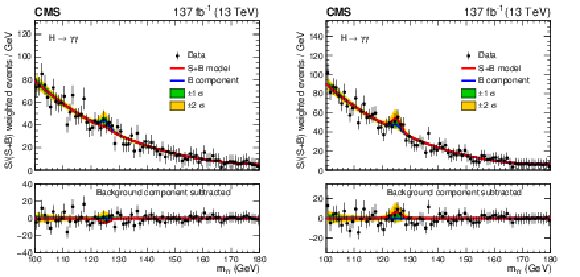
png pdf |
Figure 3:
The diphoton invariant mass distribution for the selected events from data (black points), and the results of the fits to the signal plus background models (solid red curve), and the background model alone (dotted blue curve), for the categories targeting ${\mathrm{t} \to \mathrm{H} \mathrm{u}}$ FCNC interactions (left) and ${\mathrm{t} \to \mathrm{H} \mathrm{c}}$ FCNC interactions (right). The signal model is normalized to the best-fit value. The green and yellow bands give the $ \pm $1 and $ \pm $2 standard deviation uncertainties in the background model (dotted blue curve). The background model includes ${\mathrm{H} \to \gamma \gamma}$ events from SM processes. Events are weighted by the S/(S+B) of their respective categories. The lower panels show the same information, but with the background component subtracted. |
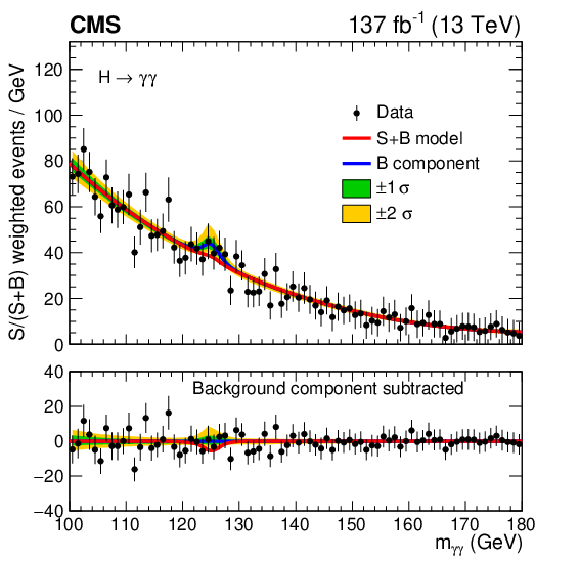
png pdf |
Figure 3-a:
The diphoton invariant mass distribution for the selected events from data (black points), and the results of the fits to the signal plus background models (solid red curve), and the background model alone (dotted blue curve), for the categories targeting ${\mathrm{t} \to \mathrm{H} \mathrm{u}}$ FCNC interactions. The signal model is normalized to the best-fit value. The green and yellow bands give the $ \pm $1 and $ \pm $2 standard deviation uncertainties in the background model (dotted blue curve). The background model includes ${\mathrm{H} \to \gamma \gamma}$ events from SM processes. Events are weighted by the S/(S+B) of their respective categories. The lower panel shows the same information, but with the background component subtracted. |
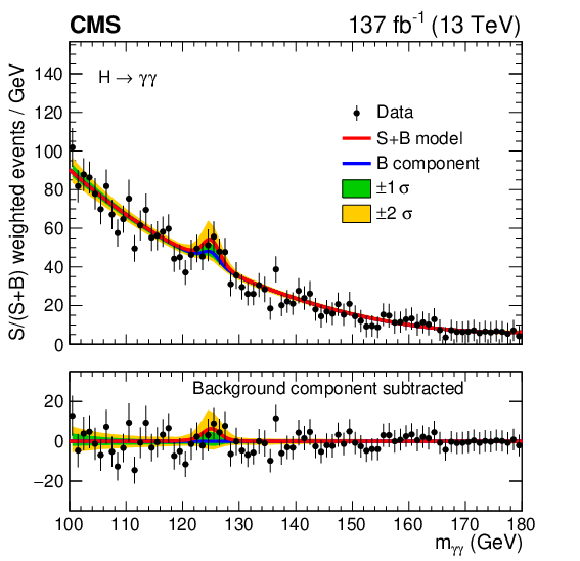
png pdf |
Figure 3-b:
The diphoton invariant mass distribution for the selected events from data (black points), and the results of the fits to the signal plus background models (solid red curve), and the background model alone (dotted blue curve), for the categories targeting ${\mathrm{t} \to \mathrm{H} \mathrm{c}}$ FCNC interactions. The signal model is normalized to the best-fit value. The green and yellow bands give the $ \pm $1 and $ \pm $2 standard deviation uncertainties in the background model (dotted blue curve). The background model includes ${\mathrm{H} \to \gamma \gamma}$ events from SM processes. Events are weighted by the S/(S+B) of their respective categories. The lower panel shows the same information, but with the background component subtracted. |
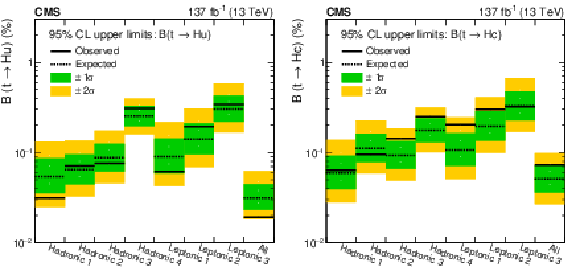
png pdf |
Figure 4:
The observed (solid line) and expected (dotted line) 95% CL upper limits on ${\mathcal B(\mathrm{t} \to \mathrm{H} \mathrm{u})}$ (left) and ${\mathcal B(\mathrm{t} \to \mathrm{H} \mathrm{c})}$ (right) for each of the hadronic and leptonic categories, defined as described in the text. The last bin gives the overall combined upper limit. The $ \pm $1 and $ \pm$2 standard deviation variations on the expected limit are given by the green and yellow bands, respectively. |
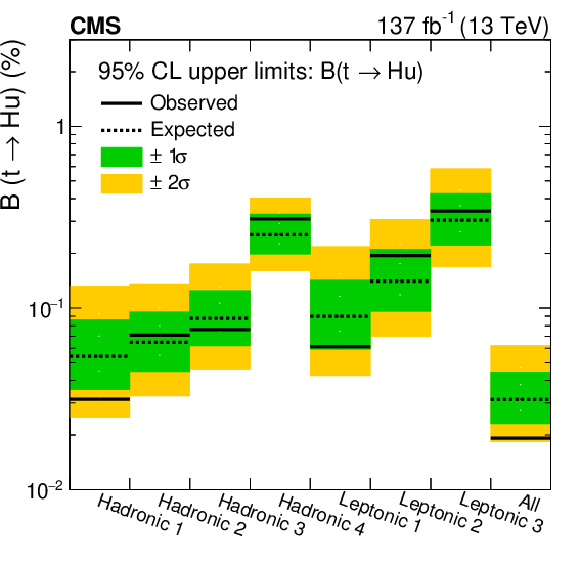
png pdf |
Figure 4-a:
The observed (solid line) and expected (dotted line) 95% CL upper limits on ${\mathcal B(\mathrm{t} \to \mathrm{H} \mathrm{u})}$ for each of the hadronic and leptonic categories, defined as described in the text. The last bin gives the overall combined upper limit. The $ \pm $1 and $ \pm$2 standard deviation variations on the expected limit are given by the green and yellow bands, respectively. |
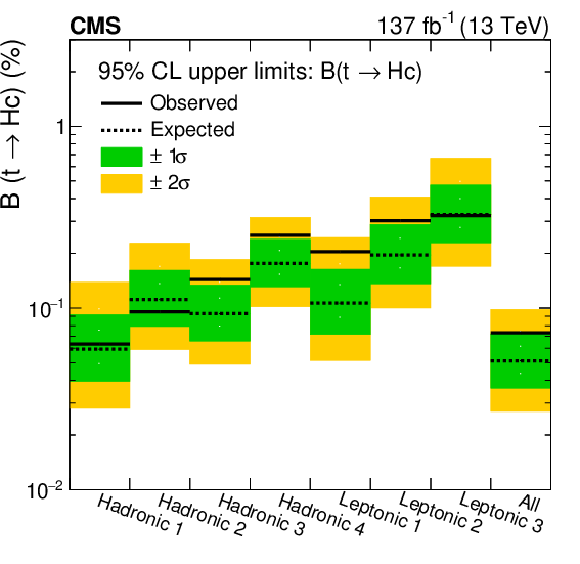
png pdf |
Figure 4-b:
The observed (solid line) and expected (dotted line) 95% CL upper limits on ${\mathcal B(\mathrm{t} \to \mathrm{H} \mathrm{c})}$ for each of the hadronic and leptonic categories, defined as described in the text. The last bin gives the overall combined upper limit. The $ \pm $1 and $ \pm$2 standard deviation variations on the expected limit are given by the green and yellow bands, respectively. |
| Summary |
| In summary, we have presented a search for flavor-changing neutral current interactions of the top quark (t) and Higgs boson (H) in proton-proton collisions at a center-of-mass energy of 13 TeV. The processes considered include both the associated production of a single top quark with a Higgs boson via an up or charm quark, and the decay of a top quark to a Higgs boson and an up or charm quark in $\mathrm{t\bar{t}}$ production. No significant excess above the background prediction is observed. The observed (expected) 95% confidence level upper limits on $\mathcal B(\mathrm{t} \to \mathrm{H}\mathrm{u})$ and $\mathcal B(\mathrm{t} \to \mathrm{H}\mathrm{c})$ of 0.019 (0.031)% and 0.073 (0.051)%, respectively, are the most stringent experimental limits published to date. |
| References | ||||
| 1 | S. L. Glashow, J. Iliopoulos, and L. Maiani | Weak interactions with lepton-hadron symmetry | PRD 2 (1970) 1285 | |
| 2 | M. Kobayashi and T. Maskawa | CP violation in the renormalizable theory of weak interaction | Prog. Theor. Phys. 49 (1973) 652 | |
| 3 | G. Eilam, J. L. Hewett, and A. Soni | Rare decays of the top quark in the standard and two Higgs doublet models | PRD 44 (1991) 1473 | |
| 4 | B. Mele, S. Petrarca, and A. Soddu | A new evaluation of the decay width in the standard model | PLB 435 (1998) 401 | |
| 5 | J. A. Aguilar-Saavedra | Top flavor-changing neutral interactions: theoretical expectations and experimental detection | Acta Phys. Polon. B 35 (2004) 2695 | hep-ph/0409342 |
| 6 | C. Zhang and F. Maltoni | Top-quark decay into Higgs boson and a light quark at next-to-leading order in QCD | PRD 88 (2013) 054005 | 1305.7386 |
| 7 | ATLAS Collaboration | Search for top-quark decays $ \mathrm{t} \to \mathrm{H}\mathrm{q} $ with 36 fb$ ^{-1} $ of pp collision data at $ \sqrt{s}= $ 13 TeV with the ATLAS detector | JHEP 05 (2019) 123 | 1812.11568 |
| 8 | A. Azatov, M. Toharia, and L. Zhu | Higgs mediated flavor changing neutral currents in warped extra dimensions | PRD 80 (2009) 035016 | 0906.1990 |
| 9 | A. Azatov, G. Panico, G. Perez, and Y. Soreq | On the flavor structure of natural composite Higgs models and top flavor violation | JHEP 12 (2014) 082 | 1408.4525 |
| 10 | S. Bejar, J. Guasch, and J. Sola | Loop induced flavor changing neutral decays of the top quark in a general two Higgs doublet model | NPB 600 (2001) 21 | hep-ph/0011091 |
| 11 | J. Guasch and J. Solà | FCNC top quark decays in the MSSM: a door to SUSY physics in high luminosity colliders? | NPB 562 (1999) 3 | |
| 12 | J. J. Cao et al. | Supersymmetry-induced flavor-changing neutral-current top-quark processes at the CERN Large Hadron Collider | PRD 75 (2007) 075021 | hep-ph/0702264 |
| 13 | J. Cao et al. | SUSY induced top quark FCNC decay $ \mathrm{t} \to \mathrm{c}\mathrm{H} $ after Run I of LHC | EPJC 74 (2014) 3058 | 1404.1241 |
| 14 | G. Eilam et al. | Top-quark rare decay $ \mathrm{t} \to \mathrm{c}\mathrm{H} $ in R-parity-violating SUSY | PLB 510 (2001) 227 | hep-ph/0102037 |
| 15 | J. A. Aguilar-Saavedra | Effects of mixing with quark singlets | PRD 67 (2003) 035003 | hep-ph/0210112 |
| 16 | W.-S. Hou | Tree level t $ \to $ cH or H $ \to $ tc decays | PLB 296 (1992) 179 | |
| 17 | K.-F. Chen, W.-S. Hou, C. Kao, and M. Kohda | When the Higgs meets the top: Search for $ t \to ch^0 $ at the LHC | PLB 725 (2013) 378 | 1304.8037 |
| 18 | I. Baum, G. Eilam, and S. Bar-Shalom | Scalar flavor changing neutral currents and rare top quark decays in a two Higgs doublet model 'for the top quark' | PRD 77 (2008) 113008 | 0802.2622 |
| 19 | C. Kao, H.-Y. Cheng, W.-S. Hou, and J. Sayre | Top decays with flavor changing neutral Higgs interactions at the LHC | PLB 716 (2012) 225 | 1112.1707 |
| 20 | B. Altunkaynak et al. | Flavor changing heavy Higgs interactions at the LHC | PLB 751 (2015) 135 | 1506.00651 |
| 21 | ATLAS Collaboration | Search for top quark decays $ \mathrm{t} \to \mathrm{q}\mathrm{H} $, with $ \mathrm{H} \to \gamma\gamma $, in $ \sqrt{s}=$ 13 TeV pp collisions using the ATLAS detector | JHEP 10 (2017) 129 | 1707.01404 |
| 22 | ATLAS Collaboration | Search for flavor-changing neutral currents in top quark decays $ \mathrm{t} \to \mathrm{H}\mathrm{c} $ and $ \mathrm{t} \to \mathrm{H}\mathrm{u} $ in multilepton final states in proton-proton collisions at $ \sqrt{s}= $ 13 TeV with the ATLAS detector | PRD 98 (2018) 032002 | 1805.03483 |
| 23 | CMS Collaboration | Search for the flavor-changing neutral current interactions of the top quark and the Higgs boson which decays into a pair of b quarks at $ \sqrt{s}= $ 13 TeV | JHEP 06 (2018) 102 | CMS-TOP-17-003 1712.02399 |
| 24 | CMS Collaboration | HEPData record for this analysis | link | |
| 25 | CMS Collaboration | The CMS experiment at the CERN LHC | JINST 3 (2008) S08004 | CMS-00-001 |
| 26 | J. Alwall et al. | The automated computation of tree-level and next-to-leading order differential cross sections, and their matching to parton shower simulations | JHEP 07 (2014) 079 | 1405.0301 |
| 27 | T. Sjostrand et al. | An introduction to PYTHIA 8.2 | CPC 191 (2015) 159 | 1410.3012 |
| 28 | CMS Collaboration | Event generator tunes obtained from underlying event and multiparton scattering measurements | EPJC 76 (2016) 155 | CMS-GEN-14-001 1512.00815 |
| 29 | CMS Collaboration | Extraction and validation of a new set of CMS PYTHIA8 tunes from underlying-event measurements | EPJC 80 (2020) 4 | CMS-GEN-17-001 1903.12179 |
| 30 | NNPDF Collaboration | Parton distributions for the LHC Run II | JHEP 04 (2015) 040 | 1410.8849 |
| 31 | NNPDF Collaboration | Parton distributions from high-precision collider data | EPJC 77 (2017) 663 | 1706.00428 |
| 32 | W. Buchmuller and D. Wyler | Effective Lagrangian analysis of new interactions and flavor conservation | NPB 268 (1986) 621 | |
| 33 | B. Grzadkowski, M. Iskrzynski, M. Misiak, and J. Rosiek | Dimension-six terms in the Standard Model Lagrangian | JHEP 10 (2010) 085 | 1008.4884 |
| 34 | A. Alloul et al. | FeynRules 2.0 - A complete toolbox for tree-level phenomenology | CPC 185 (2014) 2250 | 1310.1921 |
| 35 | C. Degrande et al. | UFO --- The Universal FeynRules Output | CPC 183 (2012) 1201 | 1108.2040 |
| 36 | J. Alwall et al. | Comparative study of various algorithms for the merging of parton showers and matrix elements in hadronic collisions | EPJC 53 (2008) 473 | 0706.2569 |
| 37 | M. Czakon and A. Mitov | Top++: A program for the calculation of the top-pair cross-section at hadron colliders | CPC 185 (2014) 2930 | 1112.5675 |
| 38 | J. Gao, C. S. Li, and H. X. Zhu | Top quark decay at next-to-next-to leading order in QCD | PRL 110 (2013) 042001 | 1210.2808 |
| 39 | N. Kidonakis | NNLL threshold resummation for top-pair and single-top production | Phys. Part. Nucl. 45 (2014) 714 | 1210.7813 |
| 40 | M. Czakon, D. Heymes, and A. Mitov | High-precision differential predictions for top-quark pairs at the LHC | PRL 116 (2016) 082003 | 1511.00549 |
| 41 | M. Czakon et al. | Top-pair production at the LHC through NNLO QCD and NLO EW | JHEP 10 (2017) 186 | 1705.04105 |
| 42 | S. Catani et al. | Top-quark pair production at the LHC: fully differential QCD predictions at NNLO | JHEP 07 (2019) 100 | 1906.06535 |
| 43 | LHC Higgs Cross Section Working Group | Handbook of LHC Higgs cross sections: 4. deciphering the nature of the Higgs sector | CERN (2016) | 1610.07922 |
| 44 | P. Nason | A new method for combining NLO QCD with shower Monte Carlo algorithms | JHEP 11 (2004) 040 | hep-ph/0409146 |
| 45 | S. Frixione, P. Nason, and C. Oleari | Matching NLO QCD computations with parton shower simulations: the POWHEG method | JHEP 11 (2007) 070 | 0709.2092 |
| 46 | S. Alioli, P. Nason, C. Oleari, and E. Re | A general framework for implementing NLO calculations in shower Monte Carlo programs: the POWHEG BOX | JHEP 06 (2010) 043 | 1002.2581 |
| 47 | H. B. Hartanto, B. Jager, L. Reina, and D. Wackeroth | Higgs boson production in association with top quarks in the POWHEG BOX | PRD 91 (2015) 094003 | 1501.04498 |
| 48 | E. Bothmann et al. | Event generation with SHERPA 2.2 | SciPost Phys. 7 (2019) 34 | 1905.09127 |
| 49 | \GEANTfour Collaboration | GEANT4 --- a simulation toolkit | NIMA 506 (2003) 250 | |
| 50 | CMS Collaboration | The CMS trigger system | JINST 12 (2017) P01020 | CMS-TRG-12-001 1609.02366 |
| 51 | CMS Collaboration | Measurements of Higgs boson properties in the diphoton decay channel in proton-proton collisions at $ \sqrt{s} = $ 13 TeV | JHEP 11 (2018) 185 | CMS-HIG-16-040 1804.02716 |
| 52 | CMS Collaboration | Measurement of the inclusive W and Z production cross sections in pp collisions at $ \sqrt{s}= $ 7 TeV | JHEP 10 (2011) 132 | CMS-EWK-10-005 1107.4789 |
| 53 | CMS Collaboration | Particle-flow reconstruction and global event description with the CMS detector | JINST 12 (2017) P10003 | CMS-PRF-14-001 1706.04965 |
| 54 | M. Cacciari, G. P. Salam, and G. Soyez | The anti-$ {k_{\mathrm{T}}} $ jet clustering algorithm | JHEP 04 (2008) 063 | 0802.1189 |
| 55 | M. Cacciari, G. P. Salam, and G. Soyez | FastJet user manual | EPJC 72 (2012) 1896 | 1111.6097 |
| 56 | CMS Collaboration | Performance of missing transverse momentum reconstruction in proton-proton collisions at $ \sqrt{s} = $ 13 TeV using the CMS detector | JINST 14 (2019) P07004 | CMS-JME-17-001 1903.06078 |
| 57 | CMS Collaboration | Identification of heavy-flavor jets with the CMS detector in pp collisions at 13 TeV | JINST 13 (2018) P05011 | CMS-BTV-16-002 1712.07158 |
| 58 | E. Bols et al. | Jet flavour classification using DeepJet | JINST 15 (2020) P12012 | 2008.10519 |
| 59 | CMS Collaboration | Performance of the DeepJet b tagging algorithm using 41.9 fb$ ^{-1} $ of data from proton-proton collisions at 13 TeV with Phase-1 CMS detector | CDS | |
| 60 | E. Spyromitros-Xioufis, W. Groves, G. Tsoumakas, and I. Vlahavas | Multi-target regression via input space expansion: treating targets as inputs | Mach. Learn. 104 (2016) 55 | 1211.6581 |
| 61 | CMS Collaboration | Performance of the CMS muon detector and muon reconstruction with proton-proton collisions at $ \sqrt{s}= $ 13 TeV | JINST 13 (2018) P06015 | CMS-MUO-16-001 1804.04528 |
| 62 | T. Chen and C. Guestrin | XGBoost: A scalable tree boosting system | in Proc. 22nd ACM SIGKDD Intern. Conf. on Knowledge Discovery and Data Mining, KDD, p. 785 ACM, New York, NY, USA | |
| 63 | CMS Collaboration | Measurements of $ \mathrm{t\bar{t}}\mathrm{H} $ production and the CP structure of the Yukawa interaction between the Higgs boson and top quark in the diphoton decay channel | PRL 125 (2020) 061801 | CMS-HIG-19-013 2003.10866 |
| 64 | CMS Collaboration | Evidence for the associated production of a single top quark and a photon in proton-proton collisions at $ \sqrt{s}= $ 13 TeV | PRL 121 (2018), no. 22, 221802 | CMS-TOP-17-016 1808.02913 |
| 65 | H. Voss, A. Hocker, J. Stelzer, and F. Tegenfeldt | TMVA, the toolkit for multivariate data analysis with ROOT | in XIth International Workshop on Advanced Computing and Analysis Techniques in Physics Research (ACAT), p. 40 2007 | physics/0703039 |
| 66 | M. J. Oreglia | A study of the reactions $\psi' \to \gamma\gamma \psi$ | PhD thesis, Stanford University, 1980 SLAC Report SLAC-R-236, see Appendix D | |
| 67 | CMS Collaboration | A measurement of the Higgs boson mass in the diphoton decay channel | PLB 805 (2020) 135425 | CMS-HIG-19-004 2002.06398 |
| 68 | P. D. Dauncey, M. Kenzie, N. Wardle, and G. J. Davies | Handling uncertainties in background shapes | JINST 10 (2015) P04015 | 1408.6865 |
| 69 | J. Butterworth et al. | PDF4LHC recommendations for LHC Run II | JPG 43 (2016) 023001 | 1510.03865 |
| 70 | A. D. Martin, W. J. Stirling, R. S. Thorne, and G. Watt | Uncertainties on $ \alpha_S $ in global PDF analyses and implications for predicted hadronic cross sections | EPJC 64 (2009) 653 | 0905.3531 |
| 71 | J. Gao et al. | CT10 next-to-next-to-leading order global analysis of QCD | PRD 89 (2014) 033009 | 1302.6246 |
| 72 | NNPDF Collaboration | Parton distributions with LHC data | NPB 867 (2013) 244 | 1207.1303 |
| 73 | CMS Collaboration | Precision luminosity measurement in proton-proton collisions at $ \sqrt{s} = $ 13 TeV in 2015 and 2016 at CMS | EPJC 81 (2021) 800 | CMS-LUM-17-003 2104.01927 |
| 74 | CMS Collaboration | CMS luminosity measurement for the 2017 data-taking period at $ \sqrt{s} = $ 13 TeV | CMS-PAS-LUM-17-004 | CMS-PAS-LUM-17-004 |
| 75 | CMS Collaboration | CMS luminosity measurement for the 2018 data-taking period at $ \sqrt{s} = $ 13 TeV | CMS-PAS-LUM-18-002 | CMS-PAS-LUM-18-002 |
| 76 | T. Junk | Confidence level computation for combining searches with small statistics | NIMA 434 (1999) 435 | hep-ex/9902006 |
| 77 | A. L. Read | Presentation of search results: the CLs technique | JPG 28 (2002) 2693 | |
| 78 | G. Cowan, K. Cranmer, E. Gross, and O. Vitells | Asymptotic formulae for likelihood-based tests of new physics | EPJC 71 (2011) 1554 | 1007.1727 |

|
Compact Muon Solenoid LHC, CERN |

|

|

|

|

|

|